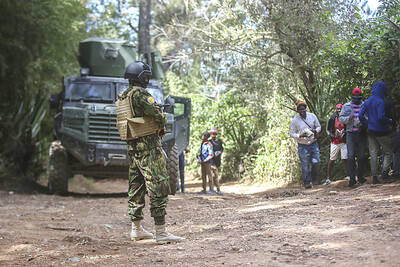Avraham Burg, former speaker of the Israeli parliament, has been stirring up trouble. In August, he charged Israel with having failed in its historic mission to be a "light unto nations" through its belligerence. He was promptly accused of encouraging "the Jew hatred sweeping all of Europe."
A few weeks ago, Burg was at it again, articulating the nightmare all Israelis fear: "Between the Jordan [River] and the Mediterranean, somewhere between next year and two years' time, there will be born the first Palestinian ... of the Palestinian majority," -- the generation of Arabs who will outnumber Israelis.
Now figures released last week show that immigration -- to a country beset by violence and a faltering economy -- has collapsed to its lowest level in 15 years, dramatically cutting the population growth.
The figures show the Achilles heel of the security policies of Prime Minister Ariel Sharon and his Likud-led government. In three years, immigration has fallen by 50 percent, a stark contrast to Sharon's avowed aim to attract a million immigrants in the next decade.
According to Israel's state statistics office, the population is now 6.75 million -- 81 percent Jewish and "other nationalities" and 19 percent Arab.
Crucially, however, the figures show that despite financial incentives for couples who have more children, the population rose last year by 116,000, or 1.7 percent -- its lowest increase since 1990.
In the 1990s, annual immigration ranged from 70,000 to 200,000 as around a million Jews from the former Soviet Union -- many of them more loosely defined as Jewish than some religious authorities would prefer -- flocked to Israel.
At the heart of all this is simple mathematics. Forecasts from the US Population Reference Bureau show Israel's population doubling in 45 years, that of the West Bank in 21 years and that of Gaza in 15 years. In other words, Palestinians in the West Bank, Gaza and East Jerusalem, and Israeli Arabs will outnumber the Jewish population by 2020.
This has led commentators such as David Landau, editor of the English-language edition of the newspaper Ha'aretz, to warn of a "cataclysmic" demographic challenge.
Landau told a symposium in San Francisco that he feared Palestinians would abandon calls for a two-state solution and insist on equal voting rights within a wider Israel -- which would end the Zionist dream.
The growing sense of panic among Israelis over the demographic time bomb underscores the bitter divisions that are emerging in Israeli society.
Of all the cases for the future of Israel and the occupied territories, the argument of the hardliners that Jews should govern the entire "historic" land of Israel is the one that would bring the moment of crisis closest. An alternative would be a policy of expulsion or transfer of population that even many hardliners who advocate it realize would make Israel an international pariah.
This same logic would undermine any attempt to remain in the occupied territories. For without expulsion Israel is faced with the choice of delivering political rights to the burgeoning population or practicing a form of political apartheid.

A fire caused by a burst gas pipe yesterday spread to several homes and sent a fireball soaring into the sky outside Malaysia’s largest city, injuring more than 100 people. The towering inferno near a gas station in Putra Heights outside Kuala Lumpur was visible for kilometers and lasted for several hours. It happened during a public holiday as Muslims, who are the majority in Malaysia, celebrate the second day of Eid al-Fitr. National oil company Petronas said the fire started at one of its gas pipelines at 8:10am and the affected pipeline was later isolated. Disaster management officials said shutting the

DITCH TACTICS: Kenyan officers were on their way to rescue Haitian police stuck in a ditch suspected to have been deliberately dug by Haitian gang members A Kenyan policeman deployed in Haiti has gone missing after violent gangs attacked a group of officers on a rescue mission, a UN-backed multinational security mission said in a statement yesterday. The Kenyan officers on Tuesday were on their way to rescue Haitian police stuck in a ditch “suspected to have been deliberately dug by gangs,” the statement said, adding that “specialized teams have been deployed” to search for the missing officer. Local media outlets in Haiti reported that the officer had been killed and videos of a lifeless man clothed in Kenyan uniform were shared on social media. Gang violence has left

US Vice President J.D. Vance on Friday accused Denmark of not having done enough to protect Greenland, when he visited the strategically placed and resource-rich Danish territory coveted by US President Donald Trump. Vance made his comment during a trip to the Pituffik Space Base in northwestern Greenland, a visit viewed by Copenhagen and Nuuk as a provocation. “Our message to Denmark is very simple: You have not done a good job by the people of Greenland,” Vance told a news conference. “You have under-invested in the people of Greenland, and you have under-invested in the security architecture of this

Japan unveiled a plan on Thursday to evacuate around 120,000 residents and tourists from its southern islets near Taiwan within six days in the event of an “emergency”. The plan was put together as “the security situation surrounding our nation grows severe” and with an “emergency” in mind, the government’s crisis management office said. Exactly what that emergency might be was left unspecified in the plan but it envisages the evacuation of around 120,000 people in five Japanese islets close to Taiwan. China claims Taiwan as part of its territory and has stepped up military pressure in recent years, including